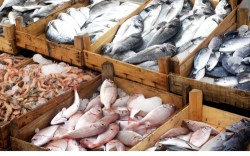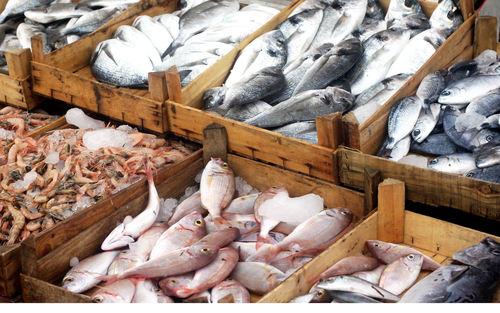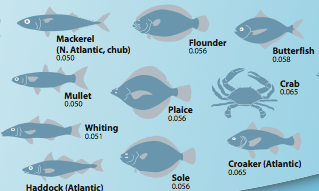
Image courtesy of Shutterstock.
Look at any seafood guide and you’re bound to come across the occasional red flag with an ominous warning: “High in Mercury.” Scary enough, but what exactly does that mean? Just how is mercury winding up in the fish on your plate?
Mercury itself isn’t a bogeyman, as it occurs naturally at low levels in rock, soil, and water throughout the world. But about half of all mercury released into the atmosphere today comes from the burning of fossil fuels like coal, oil, and natural gas, with contributions from waste incineration, mining, and other industrial activities. This mercury pollution falls directly into the ocean and other water bodies or onto land, where it can be washed into waterways. In this form, mercury poses little danger because living things can get rid of it quickly. But bacteria convert mercury as it’s carried down from the ocean surface, turning it into a highly toxic form called methylmercury.
The food chain takes it from there, as methylmercury is absorbed by phytoplankton, which are gobbled up by zooplankton, which are then feasted upon by small fish and onwards and upwards as the amount of the toxin grows in ever-accumulating quantities. The largest predatory fish in the sea, like sharks and swordfish, can have mercury concentrations in their muscles — the meat of the fish — that are 10 million times higher than those of their surrounding habitat.
Of course, the only level higher on the food chain than the largest fish is occupied by humans. And so accordingly, seafood is the source of nearly all the methylmercury that we acquire in our bodies. There’s still much to be learned about the effects of methylmercury on adults — susceptibility to mercury could be genetic, or the result of diet or stress. But there is little debate that methylmercury presents the greatest risk to fetuses, infants, and children, whose growing brains and nervous systems can be adversely affected.
So how do we reduce our exposure to mercury? The answer requires both difficult changes to the world’s energy supply and simpler consumer choices.
When it comes to energy, the good news is that, despite major pushback from the power industry, the U.S. Environmental Protection Agency’s rule to reduce 90 percent of the mercury emissions from coal-burning power plants survived a recent Senate vote. Since half of all human-generated mercury released in the United States comes from coal power plants, that’s a huge step forward towards safer fish. But the bad news is that even as the U.S. is about to choke off its mercury emissions, Asia is filling the void, because two-thirds of human-generated mercury now originates from the rapidly industrializing region. Scientists are seeing strong indications that those emissions are a major source of mercury in the North Pacific Ocean. Consider mercury just one more reason why the world should shift away from burning fossil fuels and towards renewables.
As far as consumer choices, a new report [PDF] about fish and mercury from the Blue Ocean Institute says it best: The answer isn’t to avoid seafood, it’s to avoid mercury. Particularly for pregnant or nursing women, as well as young children, the risks of mercury are significant enough to cut out high-mercury fish from their diet. But since all fish contain at least traces of methylmercury, what fish can we eat and how much? The Food and Drug Administration mercury guidelines are confusing and their suggestions questionable, but you can take matters into your own hands and try online mercury calculators from NRDC and GotMercury.org. Or check out graphics that clearly illustrate the fish with the highest and lowest levels [PDF] of mercury or suggested monthly servings.
It turns out those red flags on seafood guides don’t just represent health warnings about mercury, but remind us how the food we eat, the energy we use, and the water we depend upon are all inextricably linked.




